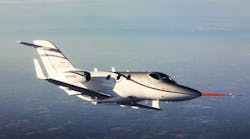Honda Aircraft Co. has started producing the HondaJet, the light business jet aircraft, that the it describes as “the fastest, highest-flying, quietest, and most fuel-efficient jet in its class.” Honda Motor Co. established Honda Aircraft in 2006 to produce business jets according to its prototype design, though production was delayed several times. It set up a manufacturing plant and maintenance center in Greensboro, N.C.
“An assembly line for HondaJet production is in place, major aircraft components including the fuselage and wing have been produced, and we have started assembly of the first customer aircraft,” stated Honda Aircraft president and CEO Michimasa Fujino, during an event at the National Business Aviation Assn. annual meeting this week. “Commencing production is the most important milestone in the HondaJet program to date, with only the future Federal Aviation Administration Type Certification and first customer delivery ranking greater in significance.”
The jets incorporate various technological innovations in aviation design, including the Over-The-Wing Engine Mount (OTWEM) configuration that improves performance and fuel efficiency by reducing aerodynamic drag. OTWEM design also reduces cabin sound, minimizes ground-detected noise, “and allows for the roomiest cabin in class, the largest baggage capacity, and a fully serviceable private aft lavatory.”
The HondaJet is powered by two GE Honda HF120 turbofan jet engines, and equipped with a glass flight deck, a Honda-customized Garmin G3000 next-generation all-glass avionics system with three 14-in. landscape-format displays, and dual touch-screen controllers.
The manufacturing plant is described as a “lean” operation designed to standardize production work and eliminate defects. Honda indicated it has developed and implemented its own production process improvement device, focused on operator work instructions while on the assembly floor. Instructions are delivered on tablet devices, so technicians can see a graphical interface that outlines individual tasks.
The plant also employs an on-site paint mixing system to achieve optimal color while reducing paint thickness in a controlled environment. This system allows for multiple aircraft to be coated with a single batch of paint, maintaining color consistency. It also pre-heats the paint, which results in a superior aesthetic quality.
Honda Aircraft said it is making “steady progress” toward delivery of the first HondaJet to customers.
Honda Aircraft stated it has completed various flight, systems and structural tests for the HondaJet over the past year including: crew seat crash tests, speedbrake testing, ultimate load tests, EASA windshield bird strike testing, wind tunnel icing tests, night lighting testing, and others.
Also, it said it recently completed the first in a series of remote tests to validate the HondaJet aircraft’s performance under extreme temperatures. These included hot-weather flight tests, hot-fuel testing, fuselage structure temperature validation, and powerplant cooling and electrical generator cooling.






